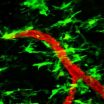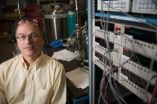Resolving conflicts over end-of-life care: Mayo experts offer tips
2012-11-28
(Press-News.org) ROCHESTER, Minn. -- It's one of the toughest questions patients and their loved ones can discuss with physicians: When is further medical treatment futile? The conversation can become even more difficult if patients or their families disagree with health care providers' recommendations on end-of-life care. Early, clear communication between patients and their care teams, choosing objective surrogates to represent patients and involving third parties such as ethics committees can help avoid or resolve conflicts, Mayo Clinic experts Christopher Burkle, M.D., J.D., and Jeffre Benson, M.D., write in the November issue of Mayo Clinic Proceedings.
"Health care professionals in the United States have struggled with the importance of maintaining patient autonomy while attempting to practice under the guidance of treatments based on beneficial care," Dr. Burkle, the study's lead author, says.
Tips from Drs. Burkle and Benson to effectively discuss end-of-life care include:
Clear communication: Early and clear communication between health care providers and patients or their surrogates is the best way to avoid disagreement over whether medical care should continue. Recent studies show that more than 95 percent of such disputes are resolved through mediated meetings involving physicians and patients/surrogates.
Choose objective surrogates if patients cannot represent themselves: The surrogate's role is to stand in the shoes of the patient and suppress his or her own judgment in favor of what the patient would have done. However, it is important to acknowledge that medical surrogates often struggle to balance their wishes for the patient with the patient's own wishes. Studies have found that not only do many surrogates fail to accurately predict a patient's treatment wishes, but when asked to resolve disputes, they are more likely to show bias by overestimating the patient's desire for continued treatment.
Involve third parties when necessary: When health care providers and patients or their advocates cannot agree on end-of-life care, involving a third party becomes necessary. Beginning in 1992, the Joint Commission, the largest hospital accreditation organization in the United States, required hospitals to establish procedures for considering ethical issues. Hospital-based ethics committees have been the most common response to this requirement.
"End-of-life care will continue to be an ongoing discussion within the medical community; however, it is important that medical care providers and patients/medical surrogates continue to dialogue," Dr. Burkle says. "Only then can experts continue to offer insight into the effectiveness of systems used in countries that have moved to a more patient-centrist approach to end-of-life care treatment choices."
###
To interview Dr. Burkle or Dr. Benson about end-of-life care, contact Alaine Westra at westra.alaine@mayo.edu or 507-284-5005.
About Mayo Clinic
Mayo Clinic is a nonprofit worldwide leader in medical care, research and education for people from all walks of life. For more information, visit http://www.mayoclinic.org/about and www.mayoclinic.org/news.
About Mayo Clinic Proceedings
The flagship journal of Mayo Clinic and one of the premier peer-reviewed clinical journals in general medicine, Mayo Clinic Proceedings is among the most widely read and highly cited scientific publications for physicians, with a circulation of approximately 124,000. While the Journal is sponsored by Mayo Clinic, it welcomes submissions from authors worldwide, publishing articles that focus on clinical medicine and support the professional and educational needs of its readers. www.mayoclinicproceedings.org
END
ELSE PRESS RELEASES FROM THIS DATE:
2012-11-28
BUFFALO, N.Y. -- You've already decided that you're going to pop the question. Now comes another quandary: Where to get the ring, if you're buying one?
The holidays are a busy time for engagements, and Trina Hamilton, a University at Buffalo expert in corporate responsibility, says socially minded consumers have a lot to think about when it comes to finding the right rock.
In recent years, shoppers have turned to Canadian diamonds as news reports and movies exposed the diamond trade's role in fueling armed conflicts in developing countries. (Think "Blood Diamond," the ...
2012-11-28
Tension is the theme running through the new consensus statement issued by the Hinxton Group, an international working group on stem cell research and regulation. Specifically, tension between intellectual property policies and scientific norms of free exchange, but also between eastern and western cultures, national and international interests, and privatized vs. nationalized health care systems.
The consensus, titled Statement on Data and Materials Sharing and Intellectual Property in Pluripotent Stem Cell Science in Japan and China, was released on the Hinxton Group's ...
2012-11-28
UNIVERSITY PARK, Pa. -- Sibling conflict represents parents' number one concern and complaint about family life, but a new prevention program -- designed and carried out by researchers at Penn State -- demonstrates that siblings of elementary-school age can learn to get along. In doing so, they can improve their future health and well-being.
"Negative sibling relationships are strongly linked to aggressive, anti-social and delinquent behaviors, including substance use," said Mark Feinberg, research professor in the Prevention Research Center for the Promotion of Human ...
2012-11-28
High-resolution real-time images show in mice how nerves may be damaged during the earliest stages of multiple sclerosis. The results suggest that the critical step happens when fibrinogen, a blood-clotting protein, leaks into the central nervous system and activates immune cells called microglia.
"We have shown that fibrinogen is the trigger," said Katerina Akassoglou, Ph.D., an associate investigator at the Gladstone Institute for Neurological Disease and professor of neurology at the University of California, San Francisco, and senior author of the paper published ...
2012-11-28
The National Science Foundation is suggesting adding a bit of spice to a geophysical scientist's research recipe of rocks, water, air, space and life:
Humans.
At next month's Fall Meeting of the American Geophysical Union (AGU) a behemoth of a conference of nearly 20,000 Earth and space scientists, educators, students and policy makers, an international group of scientists will make the case for adding the human element to their research.
The International Network of Research in Coupled Human and Natural Systems – CHANS-Net – is supported by the National Science ...
2012-11-28
LEXINGTON, Ky. (Nov. 27, 2012) -- Digoxin, a drug widely used to treat heart disease, increases the possibility of death when used by patients with a common heart rhythm problem − atrial fibrillation (AF), according to new study findings by University of Kentucky researchers. The results have been published in the prestigious European Heart Journal, and raises serious concerns about the expansive use of this long-standing heart medication in patients with AF.
UK researchers led by Dr. Samy Claude Elayi, associate professor of medicine at UK HealthCare's Gill Heart ...
2012-11-28
LA JOLLA, CA – November 27, 2012 – Researchers at The Scripps Research Institute (TRSI) are fueling the future of cancer treatment by improving a powerful tool in disease defense: the body's immune system. By revealing a novel but widespread cell signaling process, the scientists may have found a way to manipulate an important component of the immune system into more effectively fighting disease.
The study, recently published online ahead of print by the journal Blood, shows that disabling a particular enzyme, called ItpkB, in mice improves the function of a type of immune ...
2012-11-28
By using common materials found pretty much anywhere there is dirt, a team of Michigan State University researchers have developed a new thermoelectric material.
This is important, they said, because the vast majority of heat that is generated from, for example, a car engine, is lost through the tail pipe. It's the thermoelectric material's job to take that heat and turn it into something useful, like electricity.
The researchers, led by Donald Morelli, a professor of chemical engineering and materials science, developed the material based on natural minerals known ...
2012-11-28
VIDEO:
Princeton University researchers developed an enhanced approach to capturing changes on the Earth's surface via satellite that could provide a more accurate account of how geographic areas change as a...
Click here for more information.
An enhanced approach to capturing changes on the Earth's surface via satellite could provide a more accurate account of how ice sheets, river basins and other geographic areas are changing as a result of natural and human factors. ...
2012-11-28
Toronto, ON (27 November, 2012) -- A new method of growing cardiac tissue is teaching old stem cells new tricks. The discovery, which transforms aged stem cells into cells that function like much younger ones, may one day enable scientists to grow cardiac patches for damaged or diseased hearts from a patient's own stem cells—no matter what age the patient—while avoiding the threat of rejection.
Stem cell therapies involving donated bone marrow stem cells run the risk of patient rejection in a portion of the population, argues Milica Radisic, Canada Research Chair in ...
LAST 30 PRESS RELEASES:
[Press-News.org] Resolving conflicts over end-of-life care: Mayo experts offer tips




